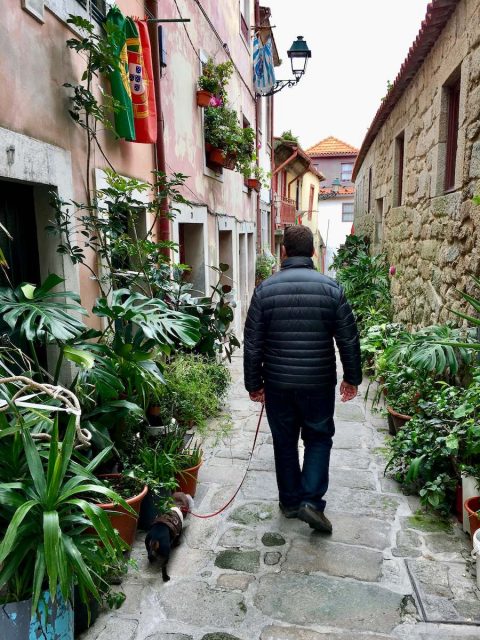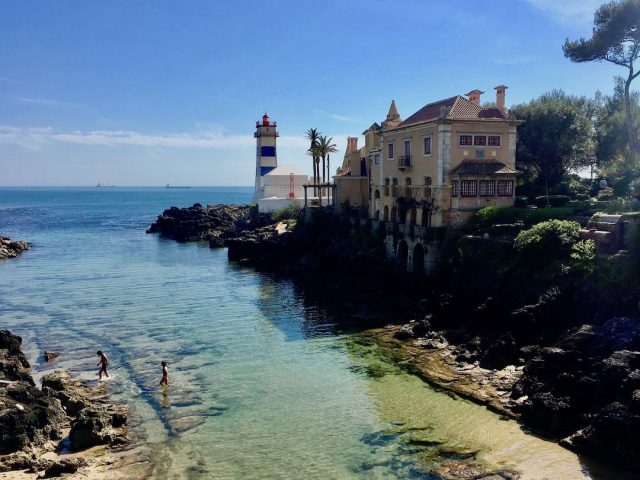I really enjoyed my visit to Portugal back in 2017 with my dog, but I can’t wait to return to this European country, for two reasons.
Firstly, we visited in March, a month that delivers a mixture of cold, rainy days and sunny, warm ones. We didn’t see Portugal in the best weather, and it was far too early to hit the beaches.
Secondly, since I visited Portugal, the law has changed to now allow dogs inside of restaurants and cafes, making it far more dog-friendly. (Particularly on those cold, rainy days!)
Here’s all the tips that you need for a fun vacation in Portugal along with your dog.

Travelling to Portugal with a Dog
If you are flying to Portugal from outside of the European Union, you need to notify the local authorities of the arrival of your pet. This applies to both cats and dogs, including service dogs.
It is required to send your pet’s documentation at least 48 hours before your arrival. A charge of €40.52 for one pet and €81.04 for two or more pets applies for the veterinary examination, except for assistance dogs. For more information, including the forms and email addresses, see the government website (translate using the buttons in the top right corner).
Otherwise, the standard rules apply for dogs arriving in Portugal, the same as for other EU countries. The standard rules also apply to dogs travelling to Portugal from another country in the EU, with a microchip, valid rabies vaccine and pet passport required.
Dining Out in Portugal with a Dog
As I mentioned above, the rules for dining at restaurants and cafes in Portugal with a dog changed not longer after our visit, in late 2017. When we visited, there was a strict ban in place against dogs being allowed inside restaurants and cafes.
Although we did come across one restaurant in Lisbon without outdoor seating that accommodated us by seating us at the entry way, almost outside… And there were plenty of awnings for outdoor dining in the rain, although I’m not sure if there were any outdoor heaters for chilly days.

However, the situation is now in line with many other countries in Europe, leaving the decision as to whether dogs are allowed inside up to the owners, as long as animals are kept out of food preparation areas.
I’ve heard from more recent travellers that it’s still not that common for pets to dine inside with their owners. But it’s always worth asking at the entry, and if they say yes it’s not breaking the rules!
Taking a Dog on Public Transport in Portugal
The situation with dogs on public transport in Portugal is better than in neighbouring Spain. Often larger dogs as well as small dogs are allowed on trains and other forms of transport.
However, note that the following breeds of dogs are regarded as dangerous in Portugal, and are not allowed on public transport: Fila Brasileiro, Dogo Argentino, Pit Bull Terrier, Rottweiler, American Staffordshire Terrier, Staffordshire Bull Terrier and Tosa Inu.
Dogs on Trains in Portugal
Trains in Portugal are operated by Comboios de Portugal. The rule for the majority of trains, including intercity and regional trains, plus urban trains in Lisbon, Porto and Coimbra, is that both small pets in a box are allowed, as well as larger dogs on a short leash and wearing a muzzle.

Small pets can travel for free, while larger dogs can travel for free on the urban trains, half-price ticket on Regional and InterRegional trains, and full-price ticket on Alfa Pendular and Intercidades trains. For larger dogs, you also need to carry their vaccination card and valid license (or presumably your pet passport).
Note that on the Celta train from Porto to Vigo in Spain only smaller pets up to 10kg in a box are allowed. The box should be no larger than 60 x 35 x 35cm, with a device to “store and remove waste” – I’m not sure what is meant!
The Sud Expresso and the Lusitânia Comboio Hotel sleeper trains the previously terminated in Lisbon ceased during March 2020 and have not been reinstated.
Dogs on Local Transport in Lisbon
On the metro in Lisbon, the rules that apply are similar to those for urban trains. Dogs need to either be in a container or on a short leash and wearing a muzzle. No ticket is required, but you should carry the dog’s vaccine record and municipal license (if applicable).
If taking a bus or tram in Lisbon, operated by Carris, their website stipulates that only pets that can be carried in an appropriate carrier, which can be carried as “hand luggage”, are permitted on board.

Dogs on Long-Distance Buses in Portugal
The rules are more generous when it comes to long-distance buses in Portugal than in many other countries, at least domestic buses.
On the coaches operated by Rede in Portugal (except international services), small dogs in an appropriate cage are allowed on board in the passenger area, with the purchase of an animal ticket. The maximum dimensions of their carrier should be 35 x 40 x 26cm. For full details, read here. Rede buses are particularly popular for trips to the Algarve Coast.
Dog-Friendly Accommodation in Portugal
According to the research that I did on the percentage of pet-friendly hotels in European cities, Lisbon in Portugal almost came at the bottom. Only 6% of hotels were marked as allowing pets, with only Dublin ranking lower. Although at least that was still 40 out of a rather large 661 hotels, guesthouses and Bed & Breakfasts.
While we were in Portugal, we didn’t actually look into staying in hotels, but instead found some wonderful Airbnbs. We mainly stayed in apartments, including a ground-floor apartment on the outskirts of Lisbon with a large backyard – perfect for our dog!

In the Douro Valley we also stayed in a delightful cottage surrounded by vineyards and complete with an open-fire. You may need to dig, but there are some great dog-friendly options for accommodation.

Dog-Friendly Sightseeing in Portugal
While in Portgual, consider including some of these dog-friendly sightseeing options in your itinerary.
1. Wander the Streets of Lisbon
It’s a difficult decision to make, but Lisbon narrowly wins out for my choice of favourite city in Portugal, probably due to the beautiful weather than we had during our visit.


Don’t miss the narrow laneways of the Alfama neighbourhood or the Miradouro de Recolhimento lookout. Be prepared for plenty of hills, unless you resort to the trams (of which the most crowded are best avoided when you are carrying a dog).

2. Taste some Port in Porto
The northern city of Porto is synonymous with port, the fortified wine named after the city. To visit one of the historical port caves and enjoy a tasting head to the south side of the Douro River to Vila Nova de Gaia.
We enjoyed an entertaining visit and a delicious tasting at Augusto’s, a boutique merchant in the district. Our small dog was welcomed to join us on the excellent tour.


Unfortunately, I’ve since heard from other visitors with dogs that dogs are no longer allowed inside on indoor tours or inside port wine tasting rooms. Double check, but perhaps instead consider a port wine tasting on one of the dog-friendly riverside terraces.
3. Cross Over the Luís I Bridge in Porto
To walk between the centre of Porto and Vila Nova de Gaia, it’s best to take the Luîs I Bridge. This historic bridge is one of the most famous landmarks of Porto.

This arched bridge is unusual in that on the low-level there is a road, while the upper-level carries the metro. It’s possible as a pedestrian to cross on both levels.
The lower level has the narrower footpath, while the upper footpath is wider and offers better views. Just keep your dog on a short leash or carry them in our arms.
Afterwards, continue through the narrow and romantic alleyways of Porto and admire the many historic buildings.

4. Explore the Douro Wine Region
The famous port wines (plus a variety of whites and reds) are grown upstream from Porto in the renown Douro wine region.

The town of Peso da Régua with its wine museum is a good base to use to explore the region. Spend a couple of days visiting vineyards, driving to scenic points and enjoying the fine restaurants in the region.
It’s best to make an advance booking for visits to wineries. We were lucky when we popped into Sandeman’s that they were about to start a tour for another couple, plus our dog was allowed to join us.

5. Taste a Portuguese Tart
You can’t visit Portugal and not enjoy a Portuguese Tart (or two, or more…) One of the most popular bakeries serving these tarts is Pastéis de Belém in the Lisbon district of Belém. The queues are often long, but move faster than you expect.

You probably need to leave your pup outside for a moment, just long enough to buy a takeaway box. Then head to the Park de Belém across the road or walk to Belém Tower. Although it’s probably best you don’t share any with your dog, they’re too good!

6. Take a Day Trip to Cascais
One of the most popular day trips when in Lisbon is to head to Sintra, with its many palaces including the colourful Pena Palace. However, dogs aren’t permitted, including in the parks, so for a dog-friendly day trip instead take the train to the beachside suburb of Cascais.

Dogs travel for free on the train, just make sure they have a leash and muzzle if they aren’t in a carrier bag. The train arrives close to the beach and harbour.
Head out for a wander through the streets then over to the coastline with its parks and coves, perhaps walking all the way to the Boca do Inferno, a natural sea archway.

7. Take a Day Trip to Guimarães
From Porto, an ideal day trip is to head to historic Guimarães on a day trip. Home to many well-preserved medieval buildings, the town is regarded as the birthplace of Portugal.
One of the highlights of a visit is Guimarães Castle, standing on a hill-top above the town. I believe we were permitted to bring our dog along inside – not that there is much to see.

Oliveira Plaza in the heart of the town is also charming.
8. Hit the Beaches of the Algarve
The beaches in the Algarve region are some of the best in all of Europe, and I can’t wait to return and hit them up. However, what about dogs, are they allowed on the beaches?
The rule in Portugal is that dogs are not allowed on “concessioned beaches” (i.e. those with beach beds and the like) with lifeguards, during the bathing season. This starts anytime between Easter and May, depending on the beach, and lasts through to October.
On the other hand, at non-concessioned beaches and where there are no signs prohibiting them by the local council, dogs should be allowed right throughout the year. However, I’ve heard reports that many beaches in the Algarve region have signs prohibiting dogs, plus these beaches are typically difficult to access.
I’ve heard reports from other visitors that some of the few year-round dog-friendly beaches include Praia do Barranquinho, Praia do Martinhal and Praia do Pinhao. So, head to one of these beaches, or instead visit the beaches of the Algarve with your dog outside of the summer season, such as during the often warm days of March and April.
There is a growing demand for dog beaches in Portugal, with two opening in recent years (North Sand Portinho Beach in Peniche, north of Lisbon, and Coral Beach at Viana do Castelo, on the far northern coast). Perhaps, a dog beach might soon be declared on the Algarve coast?
You May Also Like
About the Author

Shandos Cleaver is the founder of Travelnuity: Dog-Friendly Travel. She has travelled extensively with her Miniature Dachshund, Schnitzel, including to 33 countries across Europe, every state and territory of Australia except Tasmania, and 10 of the United States. She’s passionate about providing inspiration and information to others wanting to travel with their dogs, whether close to home or internationally.
Inspired? Pin this to your Pinterest board!


Thanks so much for all the helpful tips for pet parents who like to travel the globe with their furry kids. I wasn’t sure about bringing our Maltese boys (2) to Portugal but your blog was a big help!
That’s great to hear! Portugal was one of the first countries in Europe I visited with my dog, and we really enjoyed it!
Thanks for this we are looking at doing Porto and the Douro in September with our dog and we worried we wouldn’t be able to do any tastings or tours with her .
They were pretty relaxed about our dog! Enjoy your trip!
Really helpful – thank you!
I plan to drive around Portugal this July-August with my pug, though we are hoping to camp along the way.
Do you have any tips on dog friendly camping in Portugal?
Great to hear Naomi! Unfortunately I don’t have any experience with camping in Portugal, but usually I’ve found most campsites in Europe to be dog-friendly (including when I camped around Sweden and Norway last year). I recommend checking online in advance, or else there is usually a guidebook listing most of the campsites that you can pick up at your first stay, which will show which ones allow dogs.
Hi Shandos! My husband and I are planning a year adventure in Europe with our border collie and I am loving the information on your page – thank you! I was wondering if you have any thoughts on a somewhat economical way to get our dog into Portugal considering he won’t be able to travel on trains or buses through Spain (he is 27kgs). We looked at a car rental, which would be possible, of course, but quite pricy. Curious if you have any other thoughts :).
Shelby – That’s a tough one, hopefully one day the trains in Spain allow larger dogs! The main alternative is to fly into Portugal, although your pup would need to go as checked baggage. I can understand though if you don’t want to do this. There’s also some pet transport companies, certainly some in Spain, that may be able to transport your dog in a van across the country. I don’t have any names on hand, but Portugal Expat groups on Facebook would be able to help you out.
Hi Shelby
I’ve lived in Spain for ten years and travelled extensively with my 18 kilo dog. I’ve never been refused entry to a train to be honest. Buses and coaches it’s impossible with a larger dog, but I’ve never had an issue on trains other than being told to put a muzzle on him. It does say on the RENFE site that big dogs aren’t allowed on long-distance trains but you can always go in stages. I’ve taken my dog on train journeys of up to 3.5 hours without problem. I’m not sure about getting across the border into Portugal but you could always get a taxi for that bit. Let me know your planned route and I can and if I can help with advice, I will.
Thanks Mike, that’s great to know! I’ve heard some mixed reports about this, so it’s good to hear it can be possible.
Did you get a visa to stay in Europe for a year? Max stay is 90 days every 180 days.
Any suggestions on where to purchase a great gift for a dog who cant be with you in Portugal?
Sam – Sorry, but I’m not sure that I can think of anything. There are some lovely ceramics in the country – maybe a beautiful bowl?
I love this! Thanks for all the insight! Did you do any hikes? Were wanting to hike some trails with the pups but are not sure the regulations.
Kaylene – Unfortunately we didn’t have an opportunity to hike with our pup in Portugal, as the weather wasn’t entirely good. Based on our experiences in Spain, dogs should be allowed on most hiking trails, but may or may not require a leash. I recommend looking for signs or seeing what the locals do.
Love this! I have lived in Spain for years, but am going to start exploring Portugal with my two labradors. First trip booked for May. Your tip about airbnb was most useful. Loads of great properties that accept dogs in Portugal.
That’s great to hear Deborah!
Hi, we’re planning a trip to Portugal next month. As we love art and history, we would like to know if dogs are allowed in churches, archeological sites, the Mateus house and art galleries. Thanks for you response!
Unfortunately, even in the most dog-friendly countries, dogs are usually not allowed inside churches, unless you meet a kindly attendant who might allow dogs to be carried. Fine art galleries usually also don’t allow dogs. I’ve looked at Mateus House and would expect dogs not to be allowed inside, but I’m not sure about the gardens. At the Pena Palace in Sintra, our dog was not allowed in the gardens. You can email [email protected] to double check. I didn’t visit any archaeological sites in Portugal, so I’m not sure about whether dogs would be allowed. Dogs aren’t usually allowed at ticketed archaeological sites in Spain, so it’s probably the same in Portugal. (Italy has the most dog-friendly archaeological sites, while France was mixed, and Greece didn’t allow dogs.) Hope this helps! With sites like these, my husband and I often alternated visits or left our dog in our Airbnb apartment for the day, as he’s happy to just sleep.
Hi! First of all, I love your blog.
I’m planning to bring my service dog from NY to Lisbon this summer.
Her size fits in the cabin and we were able to fly with her last trip to Greece in 2019.
And your blog was a big help to that.
Now I’m planning to bring my service dog to Lisbon this summer.
As you mentioned, Do I need to send my pet’s documentation 48 hours before arrival? or Can I just bring local health documentation and also notify them 48 hours before arrival? I’m a bit confused the whole process and don’t know where exactly I need to call from U.S.
I’ve found “Border Inspection Post – Veterinary Service” number which is international phone call to me. Is this the number that I need to make before arrival?
Thank you.
Sorry, the link I have used is not currently working. I believe this is the new link: https://www.dgav.pt/vaiviajar/conteudo/animais-de-companhia/transito-internacional/fora-da-uniao-europeia/entrada-em-portugal/caes-e-gatos/aviso-de-chegada-como-fazer/, although this is only in Portuguese. There’s more information on the Lisbon Airport website: https://www.aeroportolisboa.pt/en/lis/passenger-guide/what-you-need-to-know/travelling-with-pets. There’s a form that you need to download from the website, fill out, add the relevant attachments and email off at least 48 hours in advance. For Lisbon Airport, the email address is [email protected] and the contact phone number is +351 919 551 607.
Can anyone tell me if there are parks etc for dogs? Having just taken our 2 dogs to Spain for 2 months we really struggled to find places to walk them ie grass. It seems Spanish dogs are happy to walk the streets on a lead whilst ours love to run free!
Sorry Sarah, I can’t remember seeing many parks in Portugal, although we mainly spent time in Lisbon and Porto, which don’t have many green spaces.
actually, Portugal and Spain, with the exception of maybe Barcelona, are extremely dogs unfriendly. for a dog-friendly country, head to Italy! France is also very dog friendly. Portugal is very inconvenient for dog owners. i hope they change.
That’s unfortunate to hear, I thought it had become more dog-friendly since I last visited. And Italy is certainly at the top of my dog-friendly country list!
Not sure where you were able to find Portuguese who were unfriendly towards dogs. I live 6 months in the Algarve and 6 months in England and I can take my dog almost everywhere with some of the exceptions mentioned in the blog and he is a big Doberman. Regards the beaches in the Eastern Algarve that stretch from east of Tavira to Villa Real San Antonio on the Spanish border. Most of the beaches allow unrestricted dog access from October to May and in the high season if you go early around 0600hrs there are so few people there and no one bothers although the fine can be as high as €2500 if Police are on patrol so I keep our walks to the dunes and forest paths that run along side the beaches. It really is such a beautiful country and this particular area is relatively unpopulated which I prefer. The cafes all allow dogs as most sitting is outside but a lot allow indoors now as well although you won’t see the dogs sitting on the chairs eating dinner like you do in France!
Hi Shandos,
I will be traveling to Portugal in June from the US with my small dog who already has a valid European pet passport. Do I still need to notify authorities and send my pet’s documentation at least 48 hours before my arrival? And will I still be required to pay for a vet exam for her even though she has a valid EU pet passport and is up to date with all vaccinations? Thanks in advance!
I haven’t seen a mention that this doesn’t apply if you have an EU pet passport, so I would still notify the authorities and send in your pet’s documentation. And ask when you email them whether the vet exam and fee applies.
All of your posts are SO HELPFUL! Thank you for taking the time to make them so detailed. My little pup and I are about to spend 3 months in Europe. I have a silly question for you…I’ve googled, but can’t seem to find anything that addresses this topic.
My pup is tiny (3.5 pounds), and she likes to be worn in a sling (like a baby) while I walk around. It’s so convenient for me too. In America, everyone always says how cute it is, but I was wondering how you think it might be perceived in Europe (France, Portugal, and Spain)? Will people look at me like I’m crazy or have you seen dogs be carried like that? I’ve only seen them in proper purses, mostly in France and Monaco, so I was just wondering what your thoughts might be, since you’ve traveled so extensively with your dog. Thanks for your time and your insight!
I can’t recall often seeing dogs carried like that when we were in Europe. But we did cine across dog slings for sale at a pet store in Paris, and considered getting one for Schnitzel. So, I’d say it’s not completely unknown, especially with small dogs. And people saw us carrying Schnitzel at times and never said anything.
Hello! Thank you so much for sharing your wonderful blog–super helpful! I know you mentioned that “you need to notify the local authorities of the arrival of your pet” if coming in to Portugal from outside of the European Union. We will be flying in from Spain, but initially flying in from the United states–so US–>Spain–>Portugal–would notifying authorities be necessary? Also, if only traveling within Europe for 21 days, do I NEED a pet passport or will the documentation for traveling from US to Europe(health certificate, micropchip, rabies vaccine)suffice? Thank you so so much!
Diana – No need to notify the authorities, this would only apply if you had initially flew from the US to Portugal. As it is, you’ll pass through customs in Spain. There’s no need for a pet passport for your travels. The EU pet health certificate is valid for 4 months travel within the EU. Try to get it stamped by customs when you arrive in Spain, but it shouldn’t be an issue if this doesn’t happen. We used our pet health certificate to travel around Spain and Portugal (by road) for 2 1/2 months, then to fly to France, where we finally got our pet’s passport. The only possible hiccup is that sometimes the airline check-in staff aren’t familiar with the pet health certificate, they are used to the pet passport. (Although often they don’t even want to look at anything!) Just make sure you allow plenty of time to check-in with your pet.
Thank you for your information. I am going to take my puppy to Lisbon in May. He has a French passport, but we are flying out from USA. So what kind of rules should I follow in order to bring him into Lisbon?
Assuming that you have an up-to-date rabies vaccine in the passport, the EU pet passport is the main item that is required. Your airline may also require a health certificate, that can be entered in the pet passport or more likely written on the vet’s letterhead. Additionally, as you’ll be flying to Portugal from outside of the EU, you’ll need to notify the authorities in advance – I provide the details.